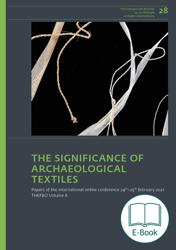Many of the common utensils used in prehistoric agricultural settlements were textile products. They were indispensable to carry out everyday tasks in the context of a sedentary lifestyle. Textiles matter – the Neolithic revolution would not have taken place without them.
From 2019 to 2021, the THEFBO project focused on “Textile craftsmanship in the prehistoric wetland settlements on Lake Constance and Upper Swabia – requirements for textiles and their perception”. Volume II of the THEFBO publications contains the proceedings of a conference held online from 24th–26th February 2021.
The everyday utensils of prehistoric agricultural settlements were, to a large extent, textile products. Functional textiles were used in everyday subsistence and helped the settlements’ inhabitants carry out tasks that were indispensable in the context of a sedentary lifestyle. In this context, the question arises as to what extent sedentariness would have been possible without textiles, simply because there is no other material that is as versatile as textile raw material. This particular topic was part of the joint project “THEFBO: Textile craftsmanship in the prehistoric wetland settlements on Lake Constance and Upper Swabia – requirements for textiles and their perception”. The project was funded by the German Federal Ministry of Education and Research from 2019 to 2021 and coordinated by the Landesamt für Denkmalpflege im Regierungspräsidium Stuttgart. Results of the project will be presented in THEFBO volume I / Forschungen und Berichte zur Archäologie in Baden-Württemberg 27.
Part of this project was an online conference from 24th–26th February 2021, the proceedings of which are presented in THEFBO volume II. It dealt with textile findings and raw materials from a dendrological, paleobotanical, textile-archaeological and cultural-historical perspective.The broad spectrum of topics gave insights into the wide range of technical textiles in prehistory. Some of the oldest and most outstanding textile finds such as early Holocene tree bast strings, ropes, and nets from Friesack 4 in Brandenburg or the strings and bags from the wells of the Early Neolithic Linear Pottery Culture were presented and discussed at the conference. Other case studies considered Neolithic basketry and cordage in the Iberian Peninsula, Neolithic and Bronze Age textiles and tools from Northern Italy, textile tools and imprints on clay sealings from Bronze Age Greece to prehistoric objects made of plant fibres and wool from ice patches in the Bernese Alps, Switzerland. Contributions discussing the distribution of Lime trees (Tilia spec.) in prehistoric European landscapes, experimental approaches to manufacturing prehistoric threads or aspects of textile terminology completed the conference.
Dr. Johanna Banck-Burgess
Johanna Banck-Burgess is a senior archaeologist at the State Office for Cultural Heritage Management in Baden-Württemberg (Landesamt für Denkmalpflege im Regierungspräsidium Stuttgart, LAD). She has been intensively involved in textile archaeology for over 30 years. She wrote her master’s thesis on Neolithic textiles in Middle-Europe. For her PhD she examined the early iron age textiles from the tumulus in Hochdorf. At the LAD, Johanna Banck-Burgess is responsible for both new and old finds stemming from current excavations.
Priv.-Doz. Dr. Elena Marinova-Wolff
Elena Marinova-Wolff is head of the Archaeobotanical Lab at the State Office for Cultural Heritage Management Baden-Württemberg (Landesamt für Denkmalpflege im Regierungspräsidium Stuttgart, LAD) and Associated Professor at the University of Tübingen. From 2007 to 2017 she was research fellow at the Centre for Archaeological Sciences, KU Leuven, Belgium and worked at several international projects in the Eastern Mediterranean and Eastern Europe dealing with past subsistence and land use practices. From 2001 to 2007 she was assistant professor at the Laboratory for Palynology, dept. Botany at the Sofia University, Bulgaria.
Prof. Dr. Doris Mischka
Since March 2013, Doris Mischka is professor for prehistory at the Friedrich Alexander University of Erlangen. She finished her master thesis in 2000 on stone artefacts from the Linear Pottery well of Erkelenz-Kückhoven and her doctoral thesis in 2004 on settlement and landscape development from the Late Neolithic to the Iron Age in the area of the southern Upper Rhine. From 2005 to 2011 she was scientific assistant at the University of Kiel and wrote a habilitation thesis on a megalithic cemetery near Flintbek. From 2011 to 2013 she worked as research assistant at the University of Göttingen.
Die „Forschungen und Berichte zur Archäologie in Baden-Württemberg “ erscheinen ab 2016 als neue, hochwertige monographische Reihe des Landesamtes für Denkmalpflege im Regierungspräsidium Stuttgart. Die neue Reihe vereint die drei etablierten archäologischen Reihen des Landesamts (Forschungen und Berichte zur Vor- und Frühgeschichte, Forschungen und Berichte der Archäologie des Mittelalters sowie die Materialhefte zur Archäologie), die sich inzwischen inhaltlich und in ihrem Umfang kaum mehr voneinander unterscheiden, in einem neuen, modernen Design.
In der Reihe erscheinen in erster Linie Monographien, daneben aber auch Sammelwerke wie z. B. Tagungsbände. Die publizierten Forschungsergebnisse resultieren vor allem aus archäologischen Ausgrabungen der Landesdenkmalpflege, die häufig im Rahmen von akademischen Abschlussarbeiten aufgearbeitet wurden. Thematisch wird die Archäologie in ihrer gesamten zeitlichen Tiefe abgedeckt, von der Vor- und Frühgeschichte über die Provinzialrömische Geschichte und das frühe Mittelalter bis zur Archäologie des Mittelalters und der Neuzeit. Die neue Reihe ist das wissenschaftliche Aushängeschild der archäologischen Denkmalpflege in Baden-Württemberg.


 Vorwort
Vorwort